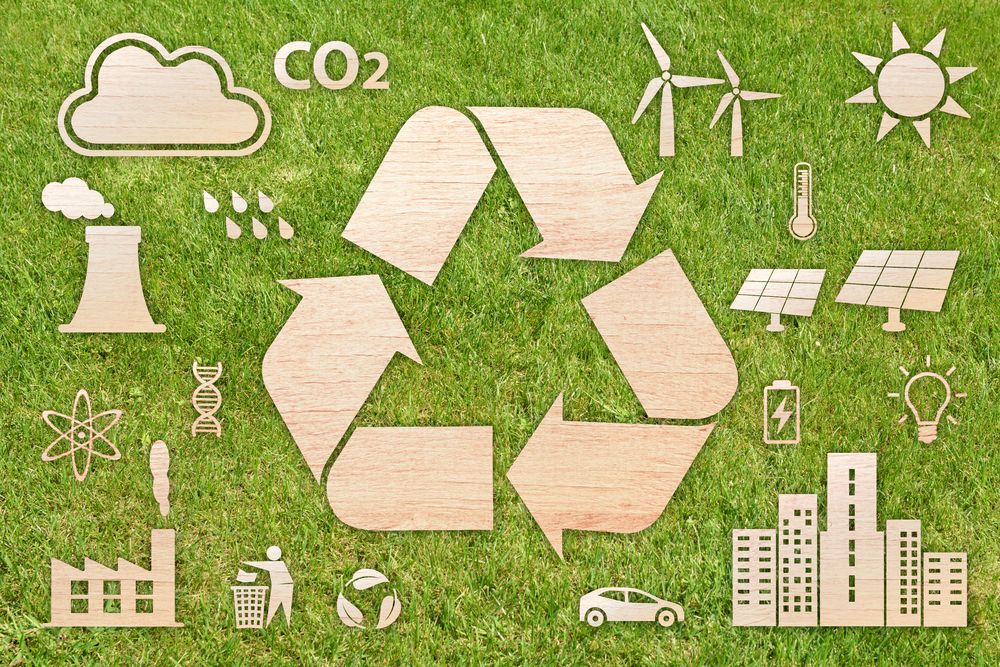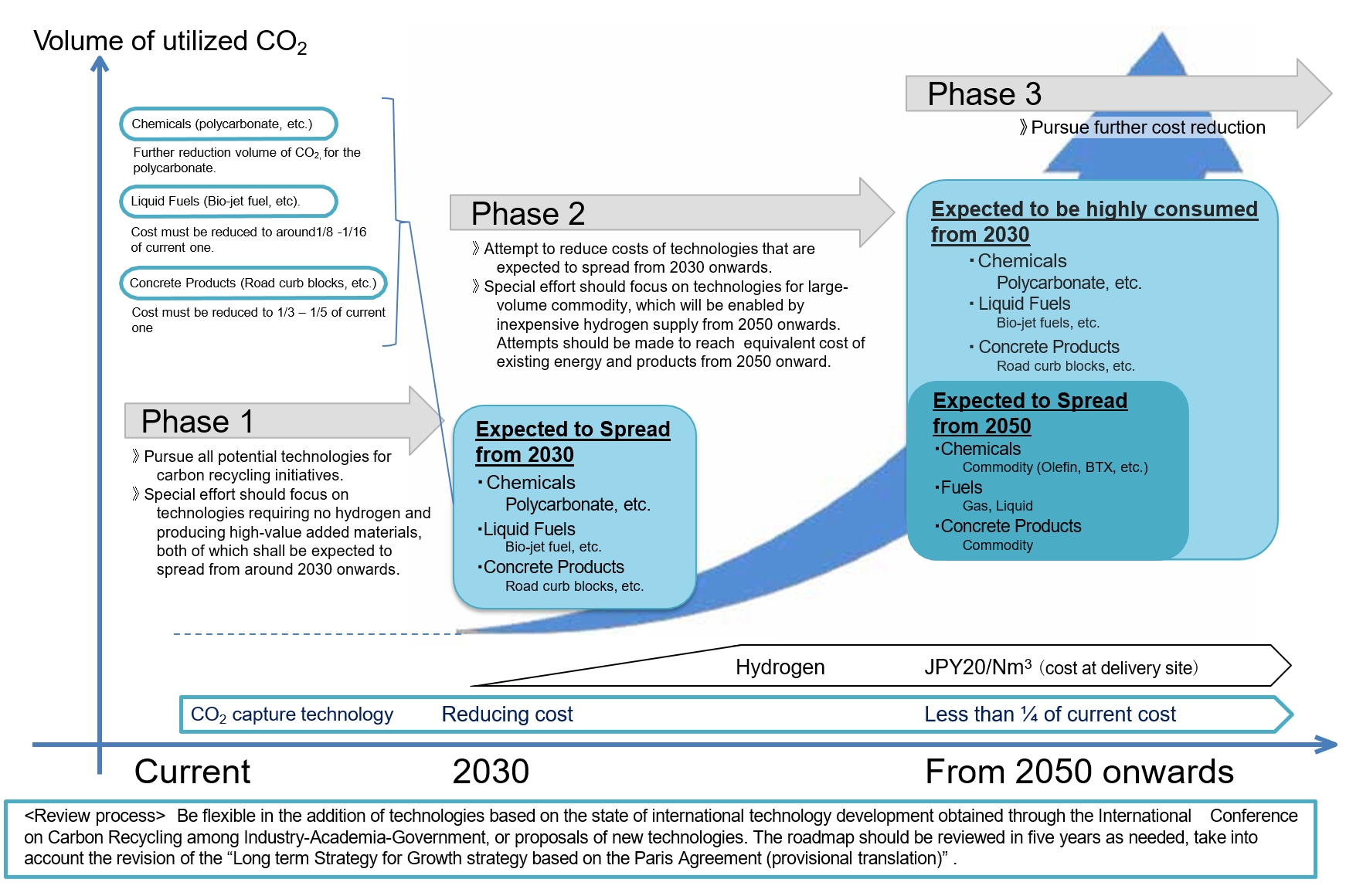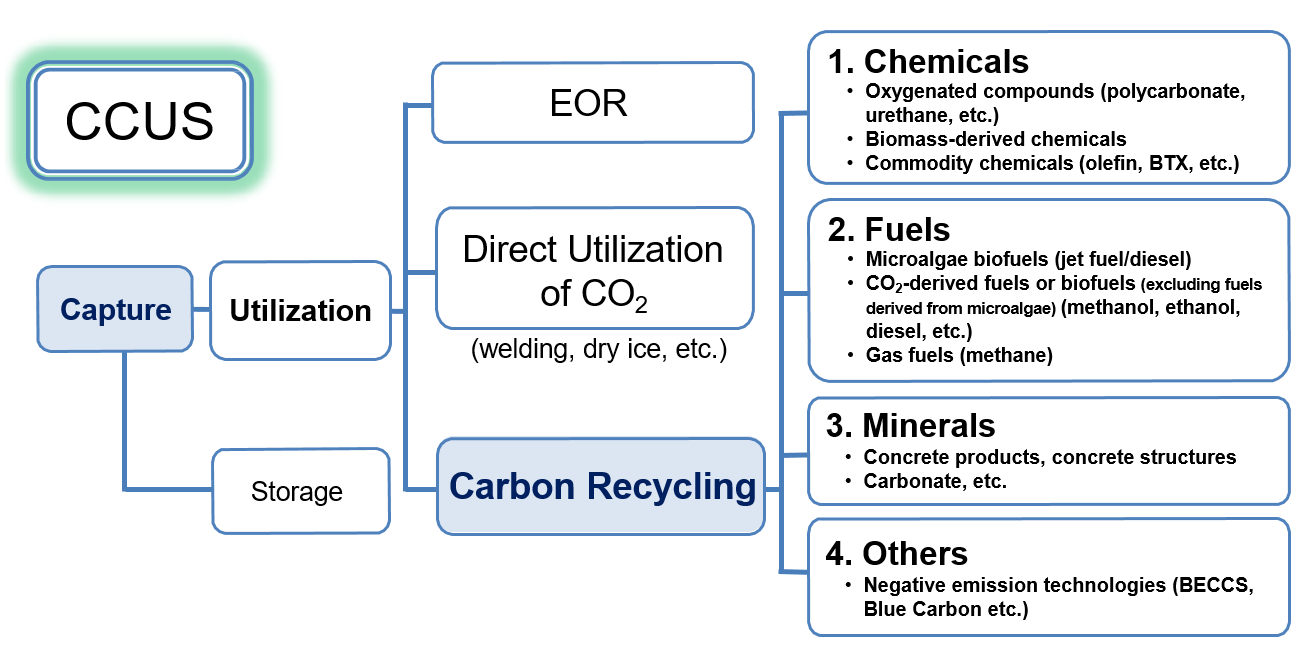CO2 may become useful in the future?! “Carbon Recycling” to utilize CO2 as a resource.
(in provisional translation)
(English ver.) 2019-12-19

It is a worldwide challenge to reduce CO2 emissions, a cause of global warming. In the energy sector, it is important to shift to sources of energy with less CO2 emissions and to improve energy efficiency as well. In addition, technologies such as CCS (Carbon dioxide Capture and Storage) to separate and remove CO2 for containment underground, and CCU (Carbon dioxide Capture and Utilization) are being studied as important technologies for reducing CO2 in the atmosphere. In order to promote further utilization of CO2 by innovations, “Carbon Recycling” is also being proposed. Let us look at the potential of CO2 utilization together with necessary technologies.
“Carbon Recycling” to reuse CO2 as materials or fuels
One of the major applications of CCU has been a technology known as EOR (Enhanced Oil Recovery). In order to maximize recovery from an oil field, materials such as water are injected at pressure into the well so that oil in the porous rocks will flow out and can be extracted. Carbon dioxide instead of water can be used for EOR.
Direct applications of CO2 include dry ice and welding. However, these applications may only use a limited amount of CO2.
The Ministry of Economy, Trade and Industry, considering CO2 as a resource, proposes to reuse it as materials and fuels which would curtail CO2 emissions. For this purpose, the Ministry advocates “Carbon Recycling” to advance innovations by global collaborations amongst industries, academia and governments for technological developments. Potential applications of CO2 are categorized into 1. Chemicals, 2. Fuels, 3. Minerals, and 4. Others, as shown below.
1. Chemicals
Oxygenated compounds such as urethane, and polycarbonate which is a kind of plastic used for making CD’s. They also include biomass-derived chemicals and versatile materials such as olefin (a generic term for resins like polypropylene and polyethylene).
2. Fuels
Photosynthetic microalgae biofuels and biomass-derived biofuels are considered as potential applications.
3. Minerals
Concrete products and concrete structures absorbing CO2 during the manufacturing process are under consideration.
4. Others
Also under consideration are technologies such as “BECCS” which combines biomass energy with CCS, and “Blue Carbon” with CO2 absorbed by seagrass/seaweed contained in the sea. These are generally referred to as “negative emission” technologies.
Products made with reused CO2 may spread by around 2030?
Technologies outlined above have been developed separately. Some of them have been commercialized with different objectives and different degrees of development.
Polycarbonate with reused CO2, for instance, has been on the market. However, this is not for the purpose of reducing CO2, but replacing the oil-derived production process that generates hazardous materials. Therefore, the amount of CO2 emitted in the production process is currently greater than that used. If CO2-free energy is utilized in the future, it may contribute to the reduction of CO2 emissions.
Concrete products with reused CO2 have already been on the market, but are only available in the form of blocks which cannot be used as building foundations. They cannot be used as reinforced concrete either due to their higher than normal acidity, which would make reinforcement bars rust easily. Due to these shortcomings, they are currently used only as road curb blocks, etc. If technological developments overcame the drawbacks, concrete products of this kind might be consumed more often.
The Ministry of Economy, Trade and Industry made public the “Roadmap for Carbon Recycling Technologies” in June, 2019 depicting challenges for technological developments in each sector of business. Based on the Roadmap, the Ministry aims to organize efficient and speedy progress of the technological developments by all sectors sharing the recognition of the current state of affairs.
Roadmap for Carbon Recycling Technologies

In “Phase 1” of the Roadmap until about 2030, all sorts of technologies that are considered potentially useful for Carbon Recycling are to be pursued. Efforts shall be focused on the technologies that are expected to start spreading from around 2030.
The usage of CO2 shall be expanded in “Phase 2” from 2030 to 2050. Polycarbonate and liquid biofuels will be spread. Concrete products, especially small products such as road curb blocks, are also expected to spread. However, these will consume only a limited amount of CO2. Therefore, technologies to make general-purpose products attracting high demand shall continue to be pursued with special efforts. On the other hand, technologies to separate and recover CO2 shall be made available at lower costs by around 2030.
In Phase 3 from 2050 onwards, efforts for further cost reduction shall be exerted. Technologies to separate and recover CO2 shall be made available at a cost of less than one-fourth of the current cost as a target. Demand for existing products such as polycarbonate will be expanding while olefin, gaseous fuels and general-purpose concrete products shall be spread in Phase 3.
What kind of technologies are required in order for more CO2 to be utilized?
What kind of technological developments are necessary to promote the usage of CO2 in various areas? The Roadmap sorts out the current status of respective technologies and challenges ahead, as well as current prices. You may understand that, before everything, cost reduction is essential as we move toward 2030.
Summary of Carbon Recycling Technologies R&D

※1 Price researched by secretariat
※2 Basic substances, chemicals(excluding some oxygenated compounds), and many technologies for fuels require large amounts of inexpensive CO2-free hydrogens.Biomass-derived fuels may require hydrogen for hydrogenation treatment, etc.
Inexpensive, CO2-free hydrogen is indispensable for most of these technologies. Currently, hydrogen is made from natural gas, the process of which requires energy. Energy is also used for resolving and bonding CO2. However, emitting CO2 in the process of creating energy would end up with nothing fruitful. For Carbon Recycling, it is essential to produce CO2-free hydrogen using electricity from “zero-emission power sources” emitting virtually zero CO2.
According to the “Basic Strategy for Hydrogen”, an ex-plant price of Hydrogen targeted for 2050 is 20 yen per Nm3 (unit of pneumatic volume), which is also taken as a target price in the Roadmap for Carbon Recycling Technologies. In the meantime, bridging technologies will be required, such as synthesis without hydrogen, and development of high-value-added materials to absorb high hydrogen costs.
Producing conventional products with Carbon Recycling technologies, even if in small quantities, would contribute to the reduction of CO2 emissions. While cost-effectiveness has to be taken into account, it is required that we establish technologies in as many sectors as possible with a view toward spreading them in the future.
Division in charge
About the article
Carbon Recycling Office, Commissioner's Secretariat
About Special Contents
Research and Public Relations Office, Policy Planning and Coordination Division, Commissioner's Secretariat
